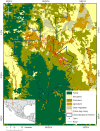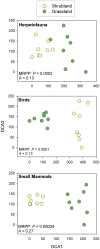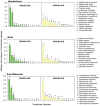Rapid decline of a grassland system and its ecological and conservation implications
- PMID: 20066035
- PMCID: PMC2797390
- DOI: 10.1371/journal.pone.0008562
Rapid decline of a grassland system and its ecological and conservation implications
Abstract
One of the most important conservation issues in ecology is the imperiled state of grassland ecosystems worldwide due to land conversion, desertification, and the loss of native populations and species. The Janos region of northwestern Mexico maintains one of the largest remaining black-tailed prairie dog (Cynomys ludovicianus) colony complexes in North America and supports a high diversity of threatened and endangered species. Yet, cattle grazing, agriculture, and drought have greatly impacted the region. We evaluated the impact of human activities on the Janos grasslands, comparing changes in the vertebrate community over the last two decades. Our results reveal profound, rapid changes in the Janos grassland community, demonstrating large declines in vertebrate abundance across all taxonomic groups. We also found that the 55,000 ha prairie dog colony complex has declined by 73% since 1988. The prairie dog complex has become increasingly fragmented, and their densities have shown a precipitous decline over the years, from an average density of 25 per ha in 1988 to 2 per ha in 2004. We demonstrated that prairie dogs strongly suppressed woody plant encroachment as well as created open grassland habitat by clearing woody vegetation, and found rapid invasion of shrubland once the prairie dogs disappeared from the grasslands. Comparison of grasslands and shrublands showed markedly different species compositions, with species richness being greatest when both habitats were considered together. Our data demonstrate the rapid decline of a grassland ecosystem, and documents the dramatic loss in biodiversity over a very short time period concomitant with anthropogenic grassland degradation and the decline of a keystone species.
Conflict of interest statement
Figures









Similar articles
-
Rapid response of a grassland ecosystem to an experimental manipulation of a keystone rodent and domestic livestock.Ecology. 2010 Nov;91(11):3189-200. doi: 10.1890/09-1277.1. Ecology. 2010. PMID: 21141180
-
Interactive Effects of Black-Tailed Prairie Dogs and Cattle on Shrub Encroachment in a Desert Grassland Ecosystem.PLoS One. 2016 May 4;11(5):e0154748. doi: 10.1371/journal.pone.0154748. eCollection 2016. PLoS One. 2016. PMID: 27144274 Free PMC article.
-
Associations of grassland bird communities with black-tailed prairie dogs in the North American Great Plains.Conserv Biol. 2013 Apr;27(2):324-34. doi: 10.1111/cobi.12013. Epub 2013 Jan 17. Conserv Biol. 2013. PMID: 23330695
-
Resilience and restoration of tropical and subtropical grasslands, savannas, and grassy woodlands.Biol Rev Camb Philos Soc. 2019 Apr;94(2):590-609. doi: 10.1111/brv.12470. Epub 2018 Sep 24. Biol Rev Camb Philos Soc. 2019. PMID: 30251329 Review.
-
Causes and consequences of woody plant encroachment into western North American grasslands.J Environ Manage. 2009 Jul;90(10):2931-42. doi: 10.1016/j.jenvman.2009.04.023. Epub 2009 Jun 5. J Environ Manage. 2009. PMID: 19501450 Review.
Cited by
-
Effects of different types of low-intensity management on plant-pollinator interactions in Estonian grasslands.Ecol Evol. 2021 Nov 22;11(23):16909-16926. doi: 10.1002/ece3.8325. eCollection 2021 Dec. Ecol Evol. 2021. PMID: 34938481 Free PMC article.
-
Grassland type and seasonal effects have a bigger influence on plant functional and taxonomical diversity than prairie dog disturbances in semiarid grasslands.Ecol Evol. 2022 Jul 13;12(7):e9040. doi: 10.1002/ece3.9040. eCollection 2022 Jul. Ecol Evol. 2022. PMID: 35845363 Free PMC article.
-
Environmental Factors Influencing Species Richness Expression in Grasslands of the Colombian Orinoquia.Plants (Basel). 2024 Dec 19;13(24):3545. doi: 10.3390/plants13243545. Plants (Basel). 2024. PMID: 39771243 Free PMC article.
-
Diversity, Abundance and Community Composition of Birds in Chitwan Annapurna Landscape, Central Nepal.Ecol Evol. 2025 Jul 14;15(7):e71781. doi: 10.1002/ece3.71781. eCollection 2025 Jul. Ecol Evol. 2025. PMID: 40666684 Free PMC article.
-
Maximizing the wildlife conservation value of road right-of-ways in an agriculturally dominated landscape.PLoS One. 2015 Mar 20;10(3):e0120375. doi: 10.1371/journal.pone.0120375. eCollection 2015. PLoS One. 2015. PMID: 25794180 Free PMC article.
References
-
- Hooper DU, Chapin FS, III, Ewel JJ, Hector A, Inchausti P, et al. Effects of biodiversity on ecosystem functioning: a consensus of current knowledge. Ecological Monographs. 2005;75:3–35.
-
- Loreau M, Naeem S, Inchausti P, editors. Biodiversity and ecosystem functioning: synthesis and perspectives. Oxford: Oxford University Press; 2002. 294
-
- Curtin CG, Western D. Grasslands, people, and conservation: over-the-horizon learning exchanges between Africa and American pastoralists. Conservation Biology. 2008;22:870–877. - PubMed
-
- Henwood WD. An overview of protected areas in the temperate grassland biome. Parks. 1998;8:3–8.
-
- FAO. The State of Food and Agriculture. Rome: Food and Agriculture Organization of the United Nations; 2006. p. 38. 239.
Publication types
MeSH terms
LinkOut - more resources
Full Text Sources

